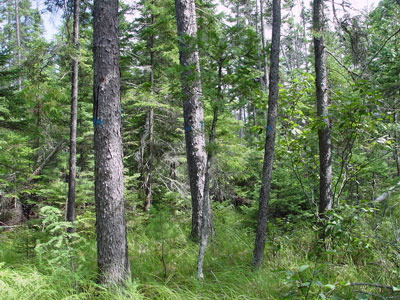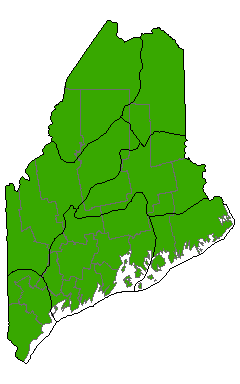DACF Home → Bureaus & Programs → Maine Natural Areas Program → Communities, Plants, and Animals → Natural Community Fact Sheets → Black Spruce Bog
Printer Friendly Fact Sheet - 850 KB pdf (Get a free copy of Adobe Acrobat Reader)
Black Spruce Bog
Scientific Name: Spruce - Larch Wooded Bog; State Rank: S4

- Community Description
- Soil and Site Characteristics
- Diagnostics
- Similar Types
- Conservation, Wildlife and Management Considerations
- Distribution
- Characteristic Plants
- Associated Rare Plants
- Associated Rare Animals
- Examples on Conservation Lands You Can Visit
Community Description: This open canopy peatland type is characterized by black spruce and/or larch trees over typical bog vegetation of heath shrubs, graminoids, and peat mosses. It is the most common type of ‘forested bog’ in Maine. Canopy closure is usually 20-50% and occasionally ranges up to 85%. Black spruce is usually dominant, but in some cases larch (or rarely fir) may be more abundant. Red maple may be a component in somewhat more minerotrophic portions, and white pine may occur on hummocks. The shrub layer, including small trees, is usually well developed (>30% cover). Labrador tea and three-seeded sedge are characteristic species. The bryoid layer has close to 100% cover and is dominated by peat mosses; sparse reindeer lichens may occur. Back to top.
Soil and Site Characteristics: Sites occur in a peatland setting, usually <1200’ elevation, characteristic of nutrient poor or highly acidic peatlands (pH 4.2-5.2). These bogs may occur as part of fens, especially in kettleholes, and are standard constituents of raised (ombrotrophic) bogs. Back to top.
Diagnostics: Canopy closure is at least 20%, with black spruce and/or larch strongly dominant, though red maple can also be present. Heath shrubs occur in the ground layer. Sites occur in a peatland setting (peat generally >30 cm deep). Back to top.
Similar Types: Dwarf Shrub Bogs and Leatherleaf Bogs, which are often adjacent on the ground, share many shrub and herb species but are considerably more open (<20% canopy cover). More minerotrophic sites tend to have wooded fens (Red Maple Fen, Open Cedar Fen), with black spruce less dominant. Back to top.
Conservation, Wildlife and Management Considerations: Black spruce bogs generally occur as part of larger peatlands. Maintaining the hydrologic integrity of the entire wetland with upland buffers is key. The trees mostly remain small and have limited economic use. Several known sites are in public ownership.
Bogs with scattered tall larch or snags provide suitable perching and foraging habitat for the rare olive-sided flycatcher. Similarly, the three-toed woodpecker inhabits bogs with large numbers of dead trees. Palm warblers, common yellowthroats, and northern waterthrushes are specialists that breed primarily in this community type. The bog elfin butterfly uses black spruce as a larval host plant. The western pine elfin uses jack pine as its host plant in the Midwest but is associated with black spruce in Maine and may be found in this community in northwestern Maine. Thaxter’s pinion moth uses larch as one of its larval hosts. Back to top.
Distribution: Statewide, especially in the New England - Adirondack Province and Laurentian Mixed Forest Province. Extending eastward, westward, and northward from Maine, and as more isolated occurrences southward. Landscape Pattern: Small to Large Patch. Back to top.


Characteristic Plants: These plants are frequently found in this community type. Those with an asterisk are often diagnostic of this community.
- Canopy
- Balsam fir*
- Black spruce*
- Gray birch*
- Red spruce*
- White pine
- Sapling/shrub
- Balsam fir*
- Black spruce*
- Larch*
- Mountain holly*
- Rhodora*
- Sheep laurel*
- Dwarf Shrub
- Black huckleberry*
- Labrador tea*
- Rhodora*
- Sheep laurel
- Velvet-leaf blueberry*
- Herb
- Balsam fir*
- Black spruce*
- Cinnamon fern*
- Creeping snowberry
- Three-seeded sedge*
- Lowbush blueberrry
- Bryoid
- Dicranum moss
- Red-stemmed moss
- Reindeer lichen
- Sphagnum mosses*
- Olive-sided flycatcher
- Rusty blackbird
Examples on Conservation Lands You Can Visit
| Example | County |
|---|---|
| Gassabias Lake, Duck Lake Public Lands | Hancock Co. |
| Moose River | Somerset Co. |
| Salmon Brook Lake Bog Public Lands | Aroostook Co. |